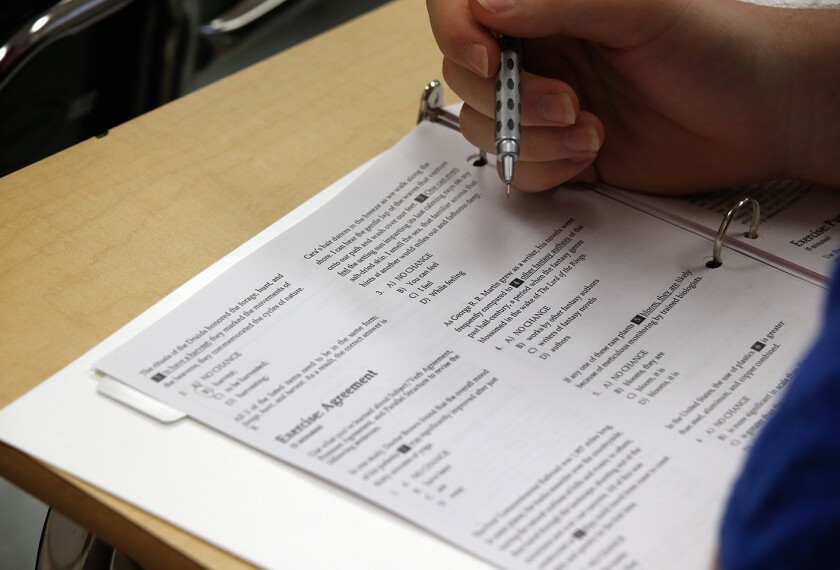Includes updates and/or revisions.
Students in the nation’s urban school districts have improved markedly in mathematics and reading proficiency as measured both on state exams and the National Assessment of Educational Progress, according to a new report by the Washington-based Council of the Great City Schools.
Released today, the council’s ninth annual “Beating the Odds” report looks at how students in urban districts stack up on state tests compared with students in their respective states as a whole. The report from the council, a Washington-based advocacy organization that represents more than five dozen of the nation’s urban school districts, also uses NAEP data to compare scores of students in big-city districts with national averages.
Urban students showed progress on both sets of data, in some cases outstripping the performance of other students in their own states and nationwide, the report says.
“It signals to me that we have a good handle on what’s working in the cities and where we need to go,” said Michael D. Casserly, the council’s executive director.
The improvement “is not as far as we like, but the trend lines continue to point in the right direction,” he said.
By using both state-level data and NAEP results, Mr. Casserly said, the report provides two independent data sources to confirm an upward trajectory for students in urban districts. “We are wanting to not only demonstrate progress, but to be transparent and signal we are not afraid of accountability,” Mr. Casserly said.
The report examines state assessment data for 4th and 8th graders from 65 school districts in 37 states and the District of Columbia. The statewide data come from administrations in the 2005-06 through 2008-09 school years.
In math, 79 percent of the urban districts examined increased the percentage of students who scored “proficient” or above on the state tests between 2006 and 2009. In that same period, 88 percent of urban districts examine increased the math scores of 8th graders on the state tests.
Reading scores on state tests also improved in the urban districts studied, according to the report. Seventy-three percent of districts showed improvement in 4th grade reading, while 71 percent showed improvement in 8th grade reading.
Among the key factors to making progress is a unified curriculum, said Winston Brooks, superintendent of the 96,000-student Albuquerque, N.M., school district. The district had 27 different reading programs being used until a year ago. Another factor, he said, was changing the community’s view of what was possible for the students.
“We had to change a culture of mediocrity to a culture of excellence,” Mr. Brooks said at a news conference releasing the results. “Our kids do have the capability to be successful.”
National Progress
For a different take on how urban districts are performing, researchers used NAEP scores from the national testing program’s “large cities” category, and compared them with NAEP scores from all public schools. At least 70 percent of students enrolled in districts in the NAEP large-cities group are members of the council.
In math, 4th graders in the large-city group moved from an average of 24 percent of students scoring at or above proficient to 29 percent between 2005 and 2009. That’s compared with 4th graders nationally, who went from 35 percent scoring at those levels to 38 percent, the report says.
Among 8th graders, average scores for large-city students rose from 19 percent scoring at or above proficient in 2005 to 24 percent in 2009. In that same period, students in the national public schools group scoring at those levels climbed from 28 percent to 33 percent.
Results were less impressive for both groups in reading. Urban 4th graders edged up from 20 percent scoring at or above proficient in 2005 to 22 percent in 2007, while students in the national group went from 30 percent to 32 percent.
Eighth graders’ scores remained static in reading during that time period, at 20 percent scoring at or above proficient for city students and 29 percent for students nationally.
The national data, too, show urban districts as a whole are making progress, in some cases scoring higher on average than districts across the nation in math, according to the report. Students in the Charlotte-Mecklenburg, N.C., district are outperforming students nationwide in 4th grade math, for example, while students in Austin, Texas, outperform the nation in 8th grade math, the report says.
“The modest gains at the national level are because the cities are pulling [national NAEP scores] up,” Mr. Casserly said.
He said that it will be challenging for districts to make further gains given the current fiscal picture. The council’s member districts are expected to lose roughly $4 billion in state and local revenue next fiscal year, Mr. Casserly said.
“It doesn’t dampen our enthusiasm or determination,” he added. “It does make it harder for that determination to get us where we need to go.”
In the 45,000-student Seattle school district, where students bested state averages in all but one category last year, superintendent Maria Goodloe-Johnson said the tough times have meant closing schools and eliminating some programs so that others central to the district’s mission have a chance to thrive.
“We have to stay the course and we have to make tough decision on what we can’t support anymore,” she said.




